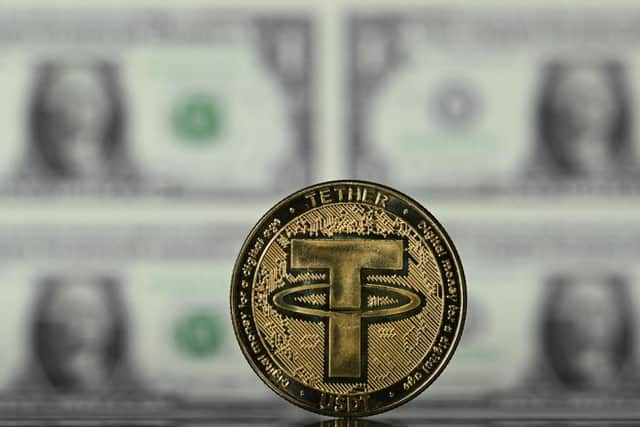What is a stablecoin? Algorithmic crypto coins explained as Terra and Luna crash - what are UST and Tether?
and live on Freeview channel 276
The recent widespread crash within cryptocurrency has reaffirmed just how volatile the technology - which is still very new and evolving - really can be, with massive prices dips after months of seemingly stable rises.
The recent downswing of Terra (LUNA) has arguably drawn the most headlines having lost over 98% of its value in a 24-hour period, but other crypto coins are suffering too.
Advertisement
Hide AdAdvertisement
Hide AdSo can anything be done to reassure investors? Are there cryptocurrencies out there that are more secure than your usual tokens?
Enter stablecoins, a form of cryptocurrency designed to be much more predictable than most others. But they’re still not 100% foolproof.
Here is everything you need to know about them.
What is a stablecoin?
Stablecoins are cryptocurrencies whose value is usually tied to a physical asset, such as a ‘real world’ currency (usually the US dollar), or traded commodities like precious or industrial metals - gold, for example.
Because they are stabilised by assets that vary outside of the highly fluid cryptocurrency space, they are designed to be less volatile than other cryptocurrencies.
Advertisement
Hide AdAdvertisement
Hide AdSince the price of Bitcoin and other cryptocurrencies are strongly connected, cryptocurrency holders cannot avoid broad price drops without abandoning the market entirely or investing instead in asset-backed stablecoins.
Since the value of a stablecoin is usually tied to a real-world asset, they are unlikely to fall below the value of those underlying physical commodities.


Taking things further, they’re also linked to world markets - when sterling rises in value on the international market, a pound-linked stablecoin would rise in value against the dollar.
Stablecoins keep reserve assets as collateral to secure price stability, and in theory, holders of such coins are also able to cash in their cryptocurrencies in exchange for the real-world equivalence at any time.
Advertisement
Hide AdAdvertisement
Hide AdIt’s not always that simple though, and some stablecoins like Tether - the biggest by market capitalisation - have faced criticism for not being able to provide audits for the reserves of physical assets they are supposed to maintain.
How stable are they?
Just because they’re called ‘stablecoins’, doesn’t mean they’ll stay reliable forever.
Take for instance the recent case of UST, the stablecoin to which the recently crashed Terra cryptocurrency had been valued against.
UST is a little bit different to traditional stablecoins, as it is an “algorithmic stablecoin”, which means it doesn’t hold physical reserves and instead employs a complicated system of “smart contracts” to keep the value as close to $1 as is feasible.
Advertisement
Hide AdAdvertisement
Hide AdHowever, UST decoupled from the dollar earlier this week, with the once stablecoin’s value falling to as low as $0.2; things have become so dire, many investors feel the UST project may never recover.
Stablecoins, despite only existing on the blockchain, are also prone to real-world events.
For example, if the vaults of Tether’s real-world collateral reserves were robbed and emptied, that would bring the price of the virtual currency crashing down.
They do have other advantages against “traditional” cryptocurrencies though, and the Bank of International Settlements lists enhanced anti-money laundering measures, customer data protection and tax compliance as just some of the benefits.
Who are they good for?
Advertisement
Hide AdAdvertisement
Hide AdThough more widespread cryptocurrencies like Bitcon are prone to wild spikes and dips in prices, that can be alluring to investors.
Imagine buying a small amount of bitcoin for a relatively low price, only for it to suddenly rocket in value. Insert cartoon dollar eyes here.
That’s all very well and good for traders, hobbyists and investors, but for those who may want to use cryptocurrencies as a more everyday form of transaction, it can be a little less appetising.
Imagine selling a product for an amount of bitcoin, only for it to quickly lose its value once the transaction has been finalised. This could see any business at a loss.
Advertisement
Hide AdAdvertisement
Hide AdInstead, stablecoins are more suited to payments, business transactions and other, more run of the mill purposes, as they are far less likely to differentiate substantially from their base worth.
In April, the UK government announced its intentions to allow stablecoins to be used as payment in the UK, bringing crypto money closer to the mainstream.
The government stated that it would look into methods to make the UK tax system more "competitive" in order for the crypto asset market to thrive.
Comment Guidelines
National World encourages reader discussion on our stories. User feedback, insights and back-and-forth exchanges add a rich layer of context to reporting. Please review our Community Guidelines before commenting.
